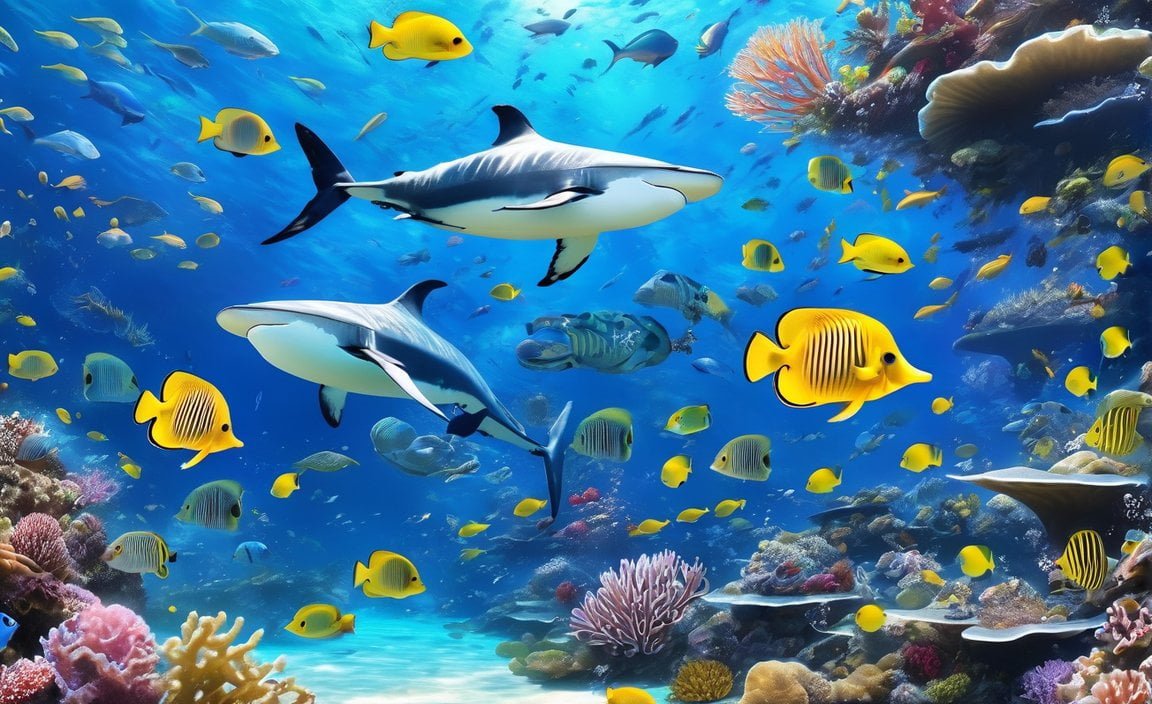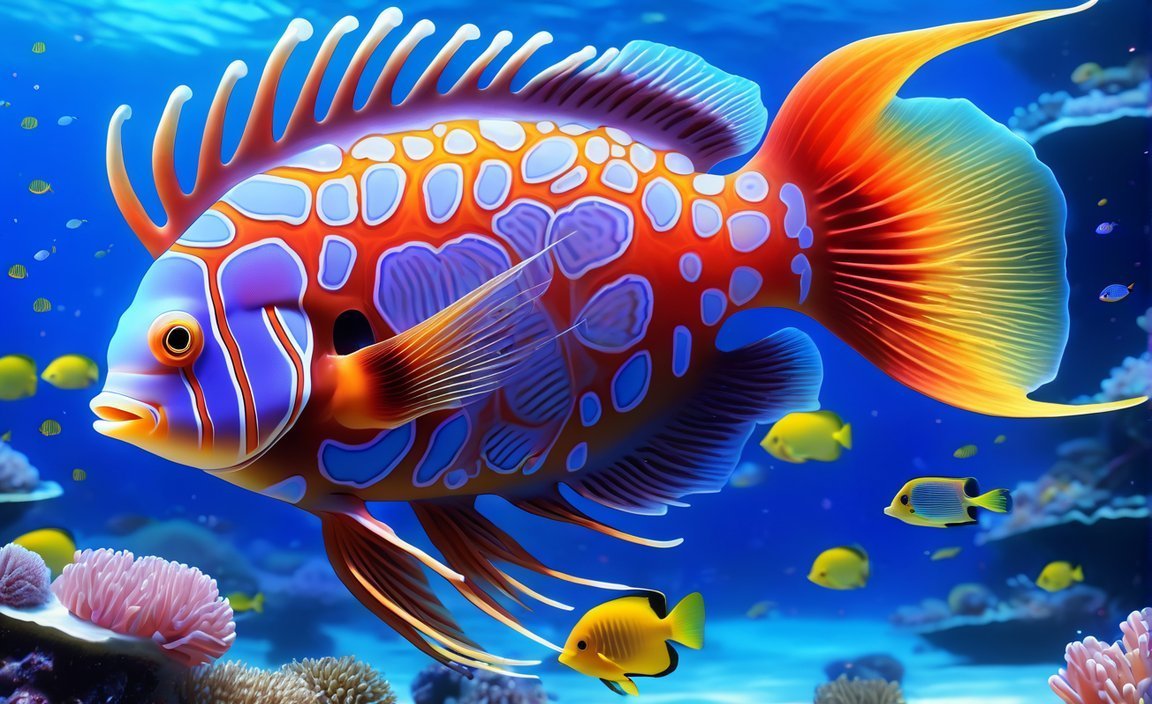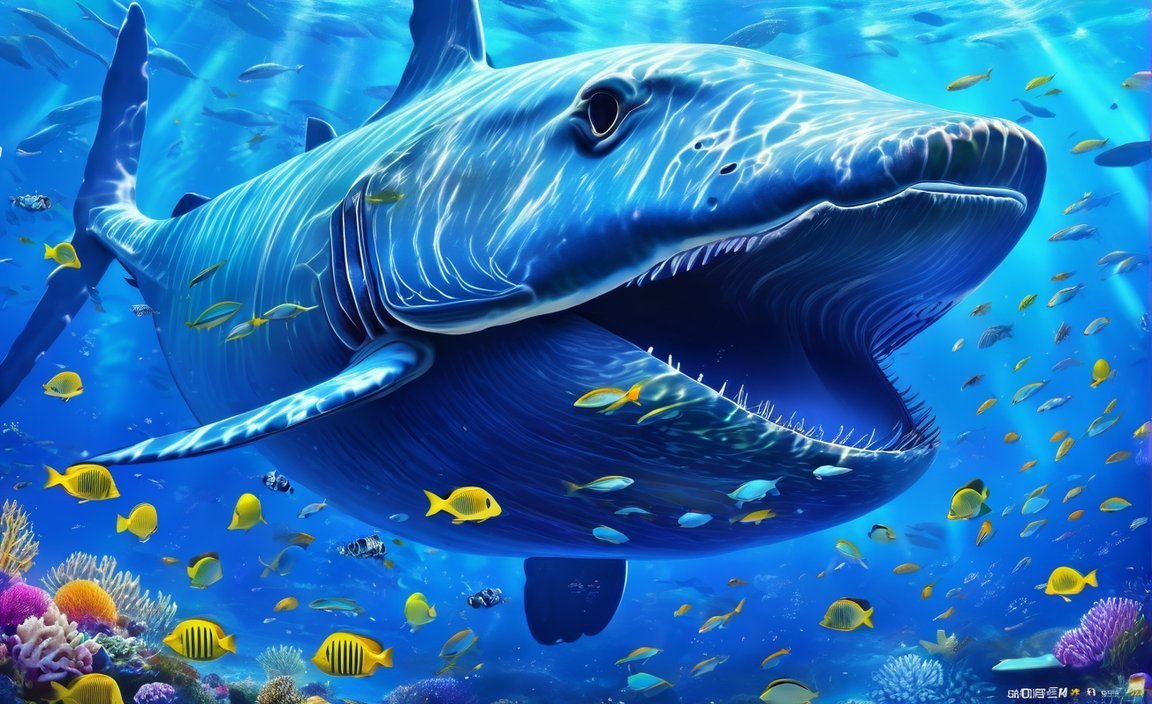Discover 10 Intriguing Facts About Marine Life and dive into the captivating world of our oceans. As an experienced marine biologist, I have conducted extensive research and witnessed the wonders of marine ecosystems firsthand. Through this article, I aim to shed light on lesser-known aspects of marine life that will fascinate and inspire readers. From extraordinary adaptations to unique behaviors, these ten facts will showcase the incredible diversity and importance of our underwater world. Join me on this journey as we uncover the hidden marvels of the ocean.

Key Takeaways:
- The speed of sound in water is almost five times faster than in air, making underwater communication unique and fascinating.
- The vastness of the oceans provides 99% of the living space on Earth, accommodating a significant portion of all forms of life.
- Jellyfish have been around for over 650 million years, predating dinosaurs and sharks, making them ancient and resilient creatures.
- Electric Eels have the amazing ability to produce enough electricity to power up to 10 electric bulbs, showcasing their extraordinary electrical capabilities.
- Dolphins exhibit a unique sleeping pattern, allowing them to rest with one eye open and only half of their brain asleep to remain alert to potential dangers.
- The Great Barrier Reef is the world’s largest living structure, home to a diverse range of marine life and providing critical eco-system services.
- The blue whale, weighing up to 200 tons, holds the title of the largest animal on Earth, highlighting the awe-inspiring size of these magnificent creatures.
- The Mariana Trench, reaching an astonishing depth of 36,070 feet, is the deepest part of the ocean, holding mysterious and largely unexplored depths.
- Sperm whales, known as the world’s largest predators, roam the ocean depths, showcasing their impressive hunting skills.
- The ocean also hosts the world’s largest animal migration, with over 1 million wildebeest crossing the Serengeti each year, demonstrating the remarkable movement of life across vast ecosystems.
Sources:
– Seashore Realty NC – 15 Interesting Facts About Marine Life
– All That’s Interesting – Ocean Animals Facts: 10 Amazing Things About Marine Life
10 Facts About Marine Life
Ever wondered what mysteries lie beneath the surface of the ocean? Marine life holds a wealth of incredible and lesser-known facts that are sure to captivate your imagination. From astonishing animals to mind-boggling phenomena, let’s dive in and explore ten intriguing facts about marine life that will leave you in awe.
1. The Speed of Sound in Water
Did you know that the speed of sound in water is almost five times faster than in air? At an impressive 1,435 meters per second, sound travels efficiently through the depths of the ocean. This high speed enables marine creatures to communicate over vast distances—much more effectively than on land.
2. The Vastness of the Ocean
The oceans cover a staggering 99% of the Earth’s living space, making them the ultimate frontier for exploration. This vast expanse provides homes for an astonishing 50-80% of all life on the planet. So, the next time you glimpse the ocean, remember that there’s a whole hidden world waiting to be discovered beneath those shimmering waves.
3. Ancient Survivors: Jellyfish
Jellyfish are true marvels of evolution. These ethereal creatures have roamed the ocean for over 650 million years, predating both dinosaurs and sharks. Their simple, yet effective design has allowed them to adapt and thrive, showcasing the incredible resilience of marine life.
4. Electrifying Eels
Electric eels possess a unique superpower—they can generate electricity! These remarkable creatures can produce enough electrical current to light up to ten electric bulbs. This adaptation allows them to navigate their murky habitats, locate prey, and even deter potential threats.
5. Dolphin Snoozing Habits
Ever wondered how dolphins manage to rest while ensuring their safety? Dolphins have a fascinating sleep strategy. They sleep with only half of their brain at a time, keeping the other half alert to watch out for predators and threats. They also keep one eye open—a true testament to their intelligence and adaptability.
6. The Marvelous Great Barrier Reef
The Great Barrier Reef is not just any underwater structure—it’s the largest living structure on our planet. This remarkable natural wonder stretches over 2,300 kilometers, harboring an incredible array of vibrant coral, fish, and marine life. It serves as a stark reminder of the breathtaking biodiversity found in our oceans.
7. Behold the Blue Whale
Prepare to be amazed by the blue whale—a true leviathan of the seas. Weighing up to 200 tons, it holds the crown for being the largest animal on Earth. These magnificent creatures can grow to lengths of over 30 meters, dwarfing any other living being. It’s a humbling reminder of the sheer grandeur of marine life.
8. Plummeting into the Mariana Trench
If you thought Mount Everest was impressive, prepare to be astonished by the Mariana Trench. Located in the western Pacific Ocean, it is the deepest part of the ocean, reaching an astonishing depth of 36,070 feet. Descending to these depths brings us into an otherworldly realm, shrouded in mystery and home to extraordinary undiscovered species.
9. The Mighty Sperm Whale
In the vast ocean, the sperm whale reigns supreme as the largest predator. These impressive creatures can be found in waters across the globe. With lengths of up to 20 meters and a unique hunting technique, they are true oceanic giants. Their presence reminds us of the diversity of marine life and the many wonders that lie beneath the waves.
10. A Migration Like No Other
While many associate migrations with the savannahs of Africa, the ocean hosts its own grand spectacle. The world’s largest animal migration takes place within its depths. Each year, over 1 million wildebeest migrate across the Serengeti, traversing vast distances in search of food and better conditions. This incredible journey is a true testament to the resilience of marine life.
From the speed of sound to the wonders of the deep, the realm of marine life is teeming with fascinating facts that continue to awe and inspire. It’s an ecosystem of unparalleled diversity and complexity, where creatures big and small have evolved extraordinary adaptations. So, the next time you find yourself at the water’s edge, take a moment to appreciate the incredible life that thrives beneath the surface. The ocean truly is a world of wonders.
Sources:
[^1^]: Seashore Realty NC – 15 Interesting Facts About Marine Life
[^1^]: All That’s Interesting – Ocean Animals Facts: 10 Amazing Things About Marine Life
Here are 10 fascinating facts about biomes. Discover the incredible diversity and unique characteristics of different ecosystems by clicking here.
Explore the intriguing process of condensation with these 10 mind-blowing facts. Uncover the science behind water vapor transforming into liquid droplets by clicking here.
Dive into the captivating world of marine biology with these 10 eye-opening facts. Learn about the fascinating creatures and ecosystems that thrive in our oceans by clicking here.
Uncover 10 astonishing facts about ocean life that will leave you in awe. Discover the wonders of underwater habitats and the incredible creatures that call them home by clicking here.
Delve into the enchanting realm of temperate deciduous forests with these 10 impressive facts. Learn about the stunning foliage, diverse wildlife, and changing seasons by clicking here.
Embark on a journey through temperate forests with these 10 intriguing facts. Explore the beauty and biodiversity of these unique habitats by clicking here.
Unearth the mysteries of temperate rainforests with these 10 captivating facts. Discover the lush vegetation, abundant wildlife, and intricate ecosystems by clicking here.
Experience the awe-inspiring wonders of the African savanna with these 10 incredible facts. Encounter majestic animals and witness their extraordinary behaviors by clicking here.
Take a deep dive into the mesmerizing world of marine life with these 10 astonishing facts. Immerse yourself in the vibrant colors and intricate ecosystems of our oceans by clicking here.
Get ready to be amazed by 10 mind-boggling facts about ocean animals. Discover the incredible adaptations and unique characteristics of these marine creatures by clicking here.
Uncover the wonders of the tropical savanna with these 10 fascinating facts. Explore the vast grasslands and encounter the diverse wildlife that thrives in this extraordinary ecosystem by clicking here.
3. The blue whale, the largest animal on the planet, calls the ocean home.
The blue whale, scientifically known as Balaenoptera musculus, is an awe-inspiring marine mammal that holds the title for being the largest animal to have ever existed on Earth. This magnificent creature calls the ocean its home, gracefully navigating through the vast depths. Let’s uncover ten fascinating and lesser-known facts about the blue whale that will leave you in wonder and awe.
1. The Titanic-Sized Dimensions:
Imagine encountering a creature that is larger than a dinosaur or even the largest land mammal. The blue whale can grow to an astounding length of 29.9 meters (98 ft), equivalent to the length of three school buses parked end to end. Its colossal weight can reach an astonishing 199 tonnes (196 long tons; 219 short tons). To put things into perspective, that’s approximately the weight of 33 adult elephants!
2. An Unforgettable Appearance:
The blue whale’s appearance is as captivating as its size. Their bodies are elongated and slender, with a sleek shape perfectly adapted for gliding through the water. With various shades of greyish-blue on their dorsal side and a lighter shade underneath, they blend beautifully with the ocean’s depths.
3. A Heart as Big as a Volkswagen Beetle:
You may think you have a big heart, but nothing compares to the blue whale. Their heart is about the size of a Volkswagen Beetle, making it the largest heart of any known creature. This incredible organ weighs around 600 kilograms (1,300 lbs). Just imagine swimming alongside a creature with a heart that enormous – it’s truly mind-boggling!
4. An Insatiable Appetite for Krill:
To fuel its massive size, the blue whale possesses an insatiable appetite. In a day, it can consume an astounding four tons of krill, which is about the weight of a small car. Their stomach capacity is equally impressive, capable of holdin
4. Coral Reefs: Biodiversity Hotspots and the Risks of Climate Change
Coral reefs are important ocean habitats known as “the rainforests of the seas” due to their significant contribution to Earth’s biodiversity. Despite occupying less than 5% of the world’s oceans, coral reefs provide a home for approximately one-fourth of all marine species. These fragile ecosystems are considered biodiversity hotspots, harboring a diverse range of marine life.
Scientific studies have shown that coral reefs support hundreds of thousands of animal and plant species, making them one of the most diverse habitats on the planet. Scientists estimate that 25% of all marine species live in and around coral reefs. These reefs are of immense value to our planet’s biodiversity and play a critical role in supporting marine life.
The National Geographic Society has extensively covered coral reefs to raise awareness about the risks they face, particularly from climate change. The society emphasizes the need to protect and preserve coral reefs, as they provide various ecological benefits. Coral reefs act as natural barriers, protecting coastlines from storms and erosion, and they also offer economic opportunities for local communities.
Conservation efforts targeted towards coral reefs are essential to avert the loss of tropical reef biodiversity. Governments, organizations, and individuals should work together to protect coral reefs and combat the threats posed by climate change, pollution, and unsustainable practices.
In-depth research and studies on coral reef ecosystems have shed light on the significance of these fragile habitats. For instance, a study published on SpringerLink highlighted the vulnerability of South Africa’s coral reefs, which are among the most-threatened habitats of their kind globally. The United Nations Environment Programme (UNEP) identifies the region from Kosi Bay to St Lucia as the fifth most threatened coastal habitat in the world.
Understanding and appreciating the value of coral reefs is crucial for their conservation. The Coral Reef Alliance emphasizes that these ecosystems have the highest biodiversity of any ecosystem on Earth, surpassing even tropical rainforests. Despite occupying less than 1% of the ocean’s surface, coral reefs contribute significantly to marine biodiversity.
It is important to involve the public, raise awareness, and support initiatives that prioritize the preservation of coral reefs. The Pew Charitable Trusts, for example, suggests six reasons why coral reefs deserve protection, highlighting their role in supporting 25% of all marine species and their potential as hotspots of biodiversity.
In conclusion, coral reefs are biodiversity hotspots that are at high risk due to climate change and human activities. Preserving and protecting these fragile ecosystems is crucial for the conservation of marine biodiversity. Efforts must be made to raise awareness, support conservation initiatives, and combat the threats that coral reefs face in order to ensure the long-term survival of these vital habitats.
References:
1. National Geographic Society. (2023). Coral Reefs. Retrieved from link
2. Earth How. (2023). Coral Reef Facts: Ocean Biodiversity Hotspots. Retrieved from link
3. Springer. (n.d.). Coral Reef: A Hot Spot of Marine Biodiversity. Retrieved from link
4. The Pew Charitable Trusts. (2022). 6 Reasons Coral Reefs Deserve Protection. Retrieved from link
5. The Deep Sea: A Haven of Mystery and Unique Creatures
The deep sea is a vast and enigmatic realm that harbors a multitude of mysterious and unique creatures, like the vampire squid. These deep-sea dwellers have adapted to survive in extreme environments, making them fascinating subjects of scientific inquiry. With an estimated 100 million or more species residing in the deep sea, it remains largely unexplored and full of potential discoveries. Here are ten captivating facts that shed light on the wonders of marine life in the deep sea:
1. Depths of Discovery:
The deep sea holds countless remarkable species yet to be discovered. Because of its extreme conditions, including high pressures, complete darkness, and frigid temperatures, life in the deep sea has evolved unique characteristics and adaptations that astound scientists.
2. Bioluminescent Brilliance:
Many deep-sea creatures possess the astonishing ability to produce light through bioluminescence. This adaptation serves various purposes, such as attracting prey, warding off predators, and communication within their dark habitat. These mesmerizing displays of light illuminate the depths, adding to the otherworldly ambiance.
3. Astonishing Adaptations:
Deep-sea creatures have evolved incredible adaptations to survive in their challenging environment. Some possess expandable jaws to capture elusive prey, while others have transparent bodies that render them nearly invisible. Such adaptations exemplify the ingenuity of nature in overcoming adversity.
4. Surreal Symbiosis:
Symbiotic relationships thrive in the deep sea, where creatures rely on each other for survival. For instance, the anglerfish uses its bioluminescent lure to attract prey, while the bacteria dwelling on its body benefit from the nutrients it provides. These intricate interactions highlight nature’s interconnectedness, even in the most extreme environments.
5. Vampire Squid: Masters of Survival:
The vampire squid, one of the deep sea’s most intriguing inhabitants, showcases remarkable adaptations. Despite their ominous name, these creatures are harmless and play an important ecological role. With webbed tentacles and glowing photophores, they navigate the dark waters and employ a unique strategy when threatened, transforming into a mysterious ball shape to confuse predators.
6. Deep Sea Mining Threats:
While the deep sea holds many secrets, it is also under threat from plans for deep-sea mining. These mining activities pose risks to delicate ecosystems and the creatures inhabiting them. Preservation efforts and sustainable alternatives are crucial to ensure the protection of this fragile and irreplaceable environment.
7. Alien-Like Encounters:
Researchers often capture awe-inspiring footage of alien-looking creatures that inhabit the deep sea. From jellyfish with vibrant, iridescent colors to anglerfish with their terrifyingly large jaws, these sightings reveal the diverse and fantastical nature of deep-sea life. These encounters ignite our imagination and demonstrate the vastness of the ocean’s mysteries.
8. A Haven for Biodiversity:
The deep sea is a treasure trove of biodiversity, housing an abundance of species that have adapted to survive in extreme conditions. Its immense darkness and cold temperatures have given rise to a plethora of unique creatures, each playing a vital role in maintaining the balance of marine ecosystems.
9. Mysterious Deep-Sea Currents:
Deep-sea currents are an intricate network of underwater highways that facilitate the dispersal of larvae, nutrients, and energy throughout the ocean realm. These currents connect distant ecosystems, allowing the exchange of lifeforms and essential resources. Understanding these currents is crucial for preserving deep-sea biodiversity.
10. Urgent Conservation Needs:
The deep sea’s fragile and vulnerable ecosystems require urgent conservation actions. As human activities, such as deep-sea mining and bottom trawling, pose significant threats, it is essential to prioritize responsible and sustainable practices to protect these remarkable habitats. By preserving the deep sea, we safeguard the wonders and potential cures that lie within it.
Key Takeaways:
- The deep sea is a realm of mystery and wonder, hosting numerous unique and mysterious creatures.
- Adaptations such as bioluminescence and extraordinary body structures enable deep-sea creatures to thrive.
- The vampire squid showcases fascinating adaptations, including its transformation into a ball when threatened.
- Plans for deep-sea mining pose risks to delicate ecosystems and require sustainable alternatives.
- Deep-sea encounters often reveal alien-like creatures and spark our imagination.
- The deep sea’s biodiversity is essential for maintaining ecological balance and understanding our planet.
- Preservation of deep-sea habitats and responsible practices are crucial for the conservation of these fragile ecosystems.
Sources:
– Greenpeace UK – Discover the mysterious creatures of the deep sea
– Live Science – 10 weird creatures found in the deep sea in 2021

FAQ
Q1: What is the speed of sound in water compared to air?
A1: The speed of sound in water is approximately five times faster than the speed of sound in air.
Q2: How much of the Earth’s living space do oceans provide?
A2: Oceans provide 99% of the living space on the planet, making them a crucial habitat for marine life.
Q3: How long have jellyfish been around?
A3: Jellyfish have been around for more than 650 million years, predating dinosaurs and sharks.
Q4: How much electricity can electric eels produce?
A4: Electric eels can produce enough electricity to light up to 10 electric bulbs.
Q5: How do dolphins sleep?
A5: Dolphins sleep with only half of their brain and with one eye open to watch for predators and threats.
Q6: What is the largest living structure on Earth?
A6: The Great Barrier Reef is the largest living structure on the planet.
Q7: What is the largest animal on Earth?
A7: The blue whale, weighing up to 200 tons, is the largest animal on Earth.
Q8: How deep is the Mariana Trench?
A8: The Mariana Trench is the deepest part of the ocean, reaching a depth of 36,070 feet.
Q9: What is the world’s largest predator in the ocean?
A9: The sperm whale is the world’s largest predator and can be found in the ocean.
Q10: What is the world’s largest animal migration?
A10: The ocean is home to the world’s largest animal migration, with over 1 million wildebeest migrating across the Serengeti each year.
- Sept 31 Myth: Unveiling Calendar Secrets - March 18, 2025
- How Long & Till December 18, 2025: Accurate Countdown Guide - March 18, 2025
- Discover Japanese Artists: A Complete History - March 18, 2025
















